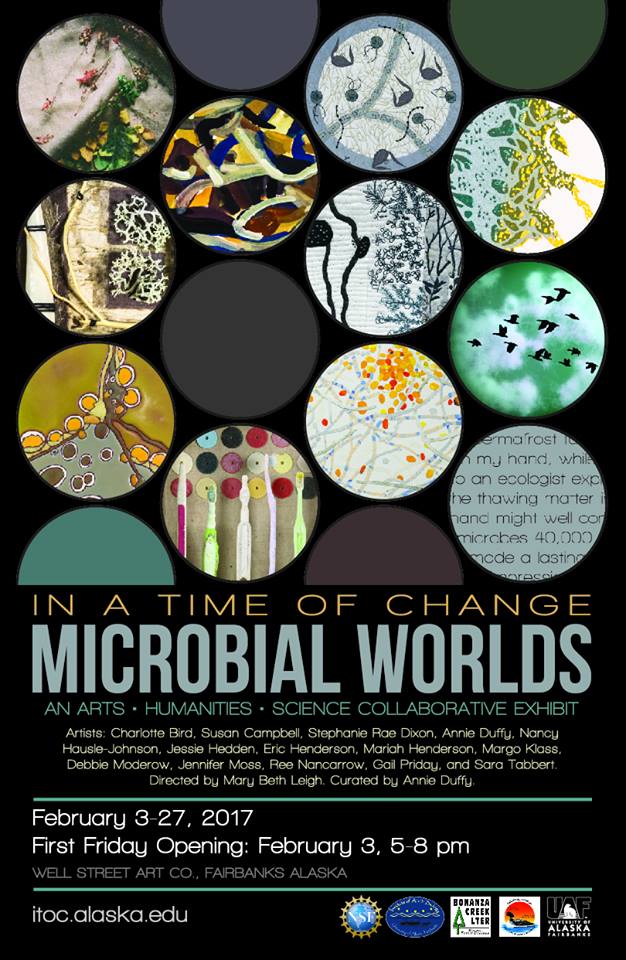"Maria Sibylla Merian, like many European women of the 17th century, stayed busy managing a household and rearing children. But on top of that, Merian, a German-born woman who lived in the Netherlands, also managed a successful career as an artist, botanist, naturalist and entomologist."Read entire article here.
Thursday, February 2, 2017
Pioneering artist/scientist rediscovered
Current art/sci exhibitions
Seeing Science
2017
Online
In A Time of Change: Microbial Worlds
February 3-27, 2017
Fairbanks, AK
2017
Online
"Photography has long been a medium for communicating science to the public and for scientific investigation. Images shape our understanding of research and technology, as well as our place in the universe.------------------------------------------
Seeing Science is a yearlong online project from the University of Maryland, Baltimore County (UMBC), with the Center for Art, Design & Visual Culture (CADVC). Curated and produced by Marvin Heiferman, it’s a portal for the diverse roles and influences of the scientific image. 'Part of what interested me is, I started out doing lots of art and museum exhibitions, but what fascinated me about science imaging in particular is its consequentiality,' Heiferman told Hyperallergic. 'The active nature of images, the active role that images play in shaping culture, is what I think science images are doing more and more.'"
In A Time of Change: Microbial Worlds
February 3-27, 2017
Fairbanks, AK
"Microbial Worlds is the culmination of 16 months of collaborative work by visual artists, writers, and scientists on the topic of microorganisms. Microbes are the most numerous and diverse organisms on the planet; they include bacteria, fungi, protozoa, algae and viruses. While some cause disease and contribute to climate change, others are responsible for promoting human health, removing toxins from the environment, and maintaining healthy ecosystems.
Under the leadership of Leigh, artists met monthly for 16 months. With Leigh and other scientists, they learned about microbiology through lectures, laboratory activities, and field trips to Toolik Field Station, Bonanza Creek Experimental Forest, and the UAF trails to learn about mushrooms and to view microbes frozen in ice on Smith Lake. Artists were also loaned microscopes in support of their independent research. The artists interacted with over 30 scientists through the course of the program, ranging from infectious disease microbiologists to ecosystem ecologists."
Recent research on art at LTERs
From the authors...
-----------------------
Over the last 15 years activities at the art-science interface have grown within the US National Science Foundation-sponsored Long-Term Ecological Research (LTER) Network, a collection of 25 sites committed to long-term, place-based investigation of the natural world.
However, there is little empirical work on the value and effectiveness of this work. After launching a survey (n = 24, all PIs in the LTER Network) in 2013 to assess the values and challenges associated with arts and humanities in the LTER Network (Goralnik et al. 2015), which identified empathy as a meaningful potential outcome of this creative work, we conducted a follow-up analysis to understand:
This research demonstrates the potential for art-humanities- science collaborations to facilitate conservation attitudes and action in the Network and beyond.
Goralnik, L., Nelson, M.P., Gosnell, H., and Leigh, M.B. 2016. Arts and humanitiesinquiry in the Long-Term Ecological Research Network: Empathy, Relationships,and Interdisciplinary Collaborations. Journal of Environmental Studies and Sciences, forthcoming.
Goralnik, L., Nelson, M.P., Gosnell, Hannah, and Ryan, Leslie. 2015. Arts and humanities efforts in the US LTER network: Understanding perceived values and challenges. In R. Rozzi, F.S. Chapin, J.B. Callicott, S.T.A. Picket, M.E. Power, J.J. Armesto, and R.H. May Jr. (EDs.) Earth Stewardship: Linking Ecology and Ethics in Theory and Practice (pp. 249-269). Springer, Berlin.
-----------------------
Over the last 15 years activities at the art-science interface have grown within the US National Science Foundation-sponsored Long-Term Ecological Research (LTER) Network, a collection of 25 sites committed to long-term, place-based investigation of the natural world.
However, there is little empirical work on the value and effectiveness of this work. After launching a survey (n = 24, all PIs in the LTER Network) in 2013 to assess the values and challenges associated with arts and humanities in the LTER Network (Goralnik et al. 2015), which identified empathy as a meaningful potential outcome of this creative work, we conducted a follow-up analysis to understand:
- the relevance of empathy in the LTER Network;
- the role of empathy in bridging arts, humanities, and science collaborations; and
- the capacity of empathy to connect wider audiences both to LTER science and to the natural world.
This research demonstrates the potential for art-humanities- science collaborations to facilitate conservation attitudes and action in the Network and beyond.
Goralnik, L., Nelson, M.P., Gosnell, H., and Leigh, M.B. 2016. Arts and humanitiesinquiry in the Long-Term Ecological Research Network: Empathy, Relationships,and Interdisciplinary Collaborations. Journal of Environmental Studies and Sciences, forthcoming.
Goralnik, L., Nelson, M.P., Gosnell, Hannah, and Ryan, Leslie. 2015. Arts and humanities efforts in the US LTER network: Understanding perceived values and challenges. In R. Rozzi, F.S. Chapin, J.B. Callicott, S.T.A. Picket, M.E. Power, J.J. Armesto, and R.H. May Jr. (EDs.) Earth Stewardship: Linking Ecology and Ethics in Theory and Practice (pp. 249-269). Springer, Berlin.
Subscribe to:
Posts (Atom)


